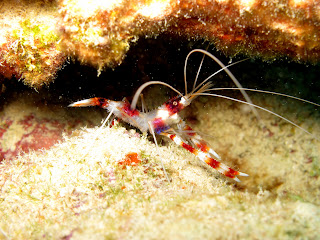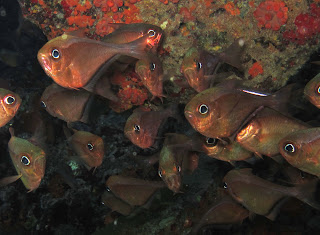The banded coral shrimp is about 1.5 to 2 inches long. We often see them waving their antennae from underneath ledges or recesses in the reef. They are cleaner shrimp, and attract fish to clean, with this slow waving.
In the photo below, a shrimp is actually cleaning the mid-section of a spotted moray eel.
Wednesday, January 30, 2013
Tuesday, January 29, 2013
The status of lionfish
About 2 years ago, predatious lionfish began invading Bonaire's reefs. This species belongs in the Indo-Pacific region, but has successfully colonized much of the Caribbean, from aquarium releases in the SE United States. Divers were not happy to see it arrive here, because it has the potential to decimate early juveniles of many species that are completely unfamiliar with it. A campaign began to knock down the population. And many divers have been certified as official lionfish hunters. As a result, this year we are seeing, many fewer lionfish on the reefs where we dive. Divers get their revenge by eating the lionfish. Several local restaurants feature lionfish on their menus.
They are striking looking fish. These guys were 6 to 8 inches long.
Today I spotted two. One (below) was about 4 inches long, and a damselfish bit me while I was trying to take this photo.
The other (below) was only about 2 inches long. At this stage, their fins are nearly translucent.
They are striking looking fish. These guys were 6 to 8 inches long.
Today I spotted two. One (below) was about 4 inches long, and a damselfish bit me while I was trying to take this photo.
The other (below) was only about 2 inches long. At this stage, their fins are nearly translucent.
Monday, January 28, 2013
Rock beauty
The rock beauty is a graceful, yellow and black angelfish. It is a little smaller than the more abundant queen angelfish and French angelfish, at 8 to 10 inches. They are a little shy, especially around my camera.
Juvenile rock beauties (see below) are pretty secretive, and hide in recesses of reef structures. Towards the back of their yellow bodies, a black spot, ringed in brilliant blue, resembles an eye. This false eye spot may confuse predators. This juvenile was a little over an inch long.
Juvenile rock beauties (see below) are pretty secretive, and hide in recesses of reef structures. Towards the back of their yellow bodies, a black spot, ringed in brilliant blue, resembles an eye. This false eye spot may confuse predators. This juvenile was a little over an inch long.
Sunday, January 27, 2013
A tale of no fish tail
Fish tails are something that we see everyday. And different species use their tails in very different ways to travel around the reef.
But today, I encountered the above smooth trunkfish with no tail, swimming almost as well without a tail as its species-mates who had tails. If the tail had been bitten off, the bite has long since healed. So, not every fish needs a tail to survive.
Below are a couple of photos of smooth trunkfish with tails. They are triangularly shaped boxfish, about 6 inches long.
Saturday, January 26, 2013
Glassy sweeper
This morning, as we were preparing to get out of the water toward the end our dive, we encountered a sizable school of glassy sweepers in a cave, just below the surface. We have occasionally seen one or two under ledges, but this was the biggest concentration that we have ever seen. They hang out in dark places by day. The name is derived from the nearly transparent appearance of their juvenile stage. This species is also commonly known as "copper sweeper" and "hatchetfish". These fish were about 4 inches long.
Friday, January 25, 2013
A minute in the life of an octopus
Another dive, another octopus. This one was really animated, and I followed it for several minutes. As digital cameras reveal the exact time that each photo was taken, I discovered that these varied shots were all taken within one minute.
The white with brown stripe phase is the swimming phase.
The white with brown stripe phase is the swimming phase.
Thursday, January 24, 2013
Looking inside sea anemones
Previously, I have seen a variety of cleaner shrimp in sea anemones. (And they still occupy many anemones.) However, this year, a number of sea anemones have juvenile bluehead wrasse associated with them. The yellow/black/white juveniles of this species also act as cleaners. These fish were less than 2 inches in length.
The terminal phase bluehead is the only phase of this species to have a blue head. This fish was about 5 inches in length. They flit around on the reef, so it took some time to get this photo (at about 20 feet).
The terminal phase bluehead is the only phase of this species to have a blue head. This fish was about 5 inches in length. They flit around on the reef, so it took some time to get this photo (at about 20 feet).
Wednesday, January 23, 2013
Foureye butterflyfish
Their name explains how this butterflyfish fools predators. Although foureye butterflyfish really have only two eyes, they have 2 large eye spots (false eye markings) that confuse predators. Their true eyes are hidden to some extent, by the black band that runs through the eye. A predator taking a quick glance will see the large eye spots, and might think the fish is much larger, and also think that the head of the butterflyfish is at the tail end.
False eye spots are not uncommon on reef fishes. This fish was about 4 inches long, and the photo was taken about 20 feet deep.
False eye spots are not uncommon on reef fishes. This fish was about 4 inches long, and the photo was taken about 20 feet deep.
Tuesday, January 22, 2013
Stoplight parrotfish
In Bonaire, parrotfish play an important ecological role on the reefs. They graze algae off rocks and coral. In some countries where parrotfish are not abundant, algae over-grows the reefs. But here, they are all over the place, and they keep Bonaire's reefs healthier. As a bonus, many of them are strikingly beautiful.
These photos are of a terminal phase stoplight parrotfish. This phase is the largest, getting up to 2 feet. However, this fish was only about 16 inches long.
These photos are of a terminal phase stoplight parrotfish. This phase is the largest, getting up to 2 feet. However, this fish was only about 16 inches long.
Monday, January 21, 2013
Gorgonians
Gorgonians are also called "soft corals". They lack the rigid skeleton of hard corals. Although they look superficially like plants, they are colonial animals. They gracefully flow back and forth with currents and tides. Sometimes, we find small fish camouflaged to blend in with the gorgonians.
These photos were taken at about 20 feet deep.
In the photo below, you can see a small slender filefish hiding in a gorgonian.
These photos were taken at about 20 feet deep.
In the photo below, you can see a small slender filefish hiding in a gorgonian.
Sunday, January 20, 2013
Lobster
On a couple of recent dives, I've spotted a Caribbean spiny lobster, under a ledge. Same ledge -- same lobster, I'm guessing. It was about 12 inches in length. This species doesn't have giant claws like the American lobster. If you look closely, you can see spines all over it, for which it was named. The lobsters mostly hide during the day, and forage at night. This lobster was about 30 feet deep.

Saturday, January 19, 2013
Views inside a sponge
Sponges on the reefs in Bonaire are varied in color, size, and shape. Vase sponges are some of my favorites. They range in color from pink to lavender to blue. Their exterior is elaborately sculptured. Peeking inside you might encounter a variety of small fish and invertebrates.
On this morning's dive, inside one I found a peppermint shrimp.
Inside another, I found a cleaning goby.
And a third sponge was occupied by a small sharpnose puffer.
The sponges were about 16 inches tall, in about 30 feet of water. The fish and shrimp were all about an inch in length.
On this morning's dive, inside one I found a peppermint shrimp.
Inside another, I found a cleaning goby.
And a third sponge was occupied by a small sharpnose puffer.
The sponges were about 16 inches tall, in about 30 feet of water. The fish and shrimp were all about an inch in length.
Friday, January 18, 2013
Razorfish
Razorfish are members of the wrasse family. They are amazing to watch, because when spooked, they dive into the sand, without a trace. They are thin, flexible, small fish. This species, the green razorfish, doesn't get bigger than about 5 inches. This fish is a male who demonstrates how they move. The fish was about 15 feet deep.
Thursday, January 17, 2013
Hide and seek on the reef
Many species try to hide on the reef. Often, little fish hide to avoid being eaten. But predators also hide, to get closer to unsuspecting prey. The spotted scorpionfish is a highly camouflaged predator (about a foot long) that lies motionless, trying to blend in with the environment.
The above photo is about as much of the spotted scorpionfish as we ever see. Along the sand you can make out its tail and pectoral fin, with the head facing right.
This fish is facing left. It looks as though vegetation is growing on it. Below, I have highlighted the same fish with red, to help outline where it ends and where the coral/rock background begins.
The above photo is about as much of the spotted scorpionfish as we ever see. Along the sand you can make out its tail and pectoral fin, with the head facing right.
This fish is facing left. It looks as though vegetation is growing on it. Below, I have highlighted the same fish with red, to help outline where it ends and where the coral/rock background begins.
Subscribe to:
Comments (Atom)

















































